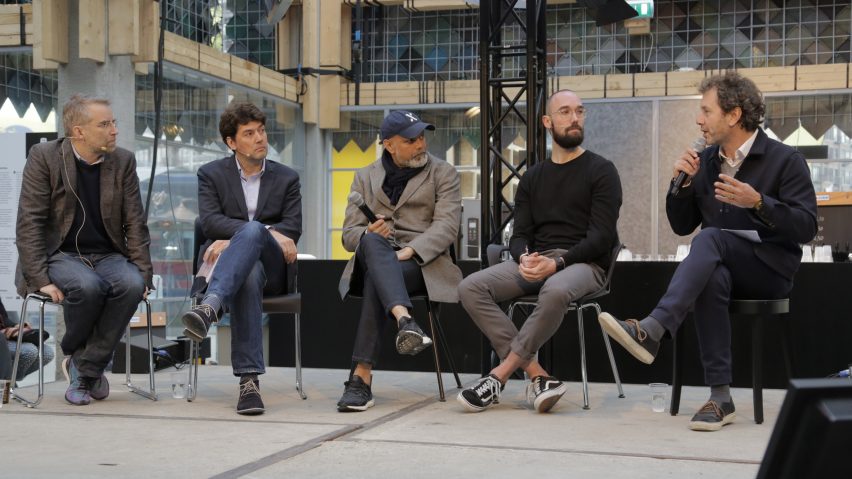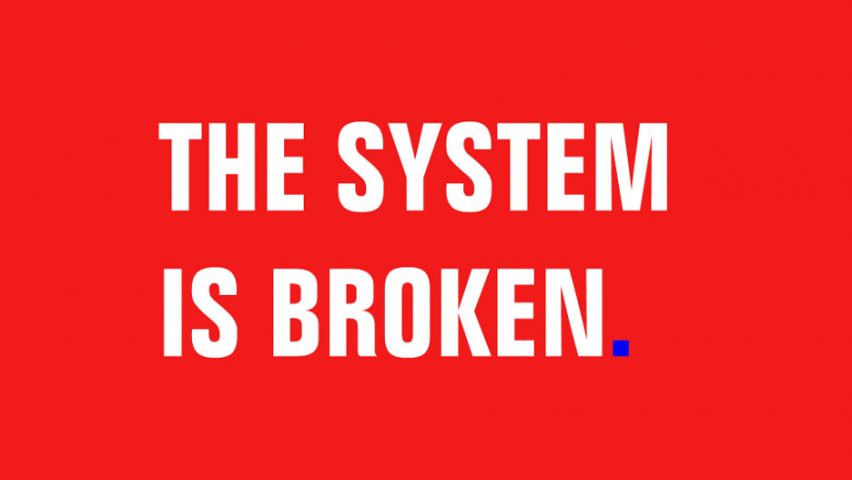Design can help change the system, say speakers at Dezeen's politics talk
Designers can influence politicians by proposing "10,000 little steps" to improve the world, according to speakers at our final Good Design for a Bad World talk at Dutch Design Week.
Panelists at the talk, which looked at how design can impact the political sphere, said that many small ideas could prove more effective than a few big ones.
"If designers just start doing what they are really good at, then politicians will follow," said Jan Boelen, artistic director of Z33 House for Contemporary Art in Hasselt, Belgium, and curator of this year's Istanbul Design Biennial. "Then the energy goes to the right stuff."
"We should look into probably 10,000 little steps and little solutions and little questions."

Politics is becoming irrelevant to ordinary people and needs a redesign, the panel agreed, and designers can help by communicating ideas for a better world that both politicians and the public can understand.
"Fifty percent of Dutch people don't feel engaged" in politics any more, said fellow panelist Rudy van Belkom. "They feel like the system is broken. They have a lack of hope; they don't trust the system any more."
Van Belkom, who describes himself as a "transition designer", asked the audience of around 150 people how many of them belonged to a political party.
People have disengaged with politics
"If you are, please stand up," he said. "So that's like none. Zero. Oh sorry, there's one. So there's one member of a political party, so it's kind of an endangered species almost."
People have disengaged with politics, Van Belkom said, pointing out that the Dutch election process has hardly changed since it was introduced in 1918 and is now irrelevant to the way people live.
"That's a hundred years ago," he said. "I think design can help to change the system, not only the political systems or the politicians, but also citizens because I think most people don't vote that informed."
Van Belkom has proposed an alternative voting system, similar to an à-la-carte menu, where people can select policies from different parties. The designer described his proposal, called Het Nieuwe Kiezen or "the new vote", in an interview with Dezeen published earlier this year.
Panelist Lennart Booij encouraged designers to show politicians how their skills could solve problems, rather than hoping that politicians will speak up for design.
Politicians aren't interested in risky design concepts
Politicians are "very enthusiastic about [design] the moment it helps them win, if it helps to get out the message as they call it," said Booij, an art historian and former campaign leader for Wim Kok, who was Dutch prime minister from 1994 to 2002.
"But the moment design demands all sort of questions on more difficult topics, you can maybe lose your voters on it," he said.
Politicians are risk-averse, he said, and would shy away from supporting radical ideas that might make them unpopular. "We are now living in a non risk-taking society," he said. "There's a lot of fear of losing focus by going too fast or having a real outspoken agenda."

Van Boelen, Booij and Van Belkom were speakers at Dezeen's politics talk, held during Dutch Design Week in Eindhoven last October as part of our Good Design for a Bad World series of discussions.
The talk explored whether designers can influence politics at a time of rising populism and global challenges such as population movements and climate change.
In these fields, Booij said that designers can offer solutions that politicians would welcome, he said.
"It's not a coincidence that we are having this talk right now because when you look around, you see that design [can] solve problems," he said. "I get emails from local politicians. They say 'Rudy, you came up with a new voting system, can you also come up with a new…'. They feel that people are not satisfied anymore. And I think especially on a local level, politicians really feel it."
Designers and politicians need to talk more
But is there sufficient dialogue between designers and politicians? Are politicians aware that design could help?
"They don't really know maybe what the answers are or what design could do, but they do feel it," Booij said. And I think that's a really good starting point."
"Design can help to pull the politicians to the next level, especially when you see all those great proposals already here presented with the young generation at the Design Academy," Booij added, referring to the influential Design Academy Eindhoven. 'The time is ripe and there are so many doors to be opened right now, and we need politicians to understand that and to give the right push."
But other panelists felt that, rather than wasting time trying to engage directly with politicians, they should focus their energies on producing great ideas.
"Maybe it's more important today to question situations, to understand them, to unveil them, to unmake them, to unlearn, rather than to try to solve big problems," said Boelen.
We need 10,000 solutions instead of just one
"I feel always very optimistic when I'm in Eindhoven, because I see so many young people really working and re-thinking structures, ideas and so on," said Booij.
"So it is possible, but it's a step by step approach. It is indeed 10,000 solutions instead of just one. And it's about making the connections, connecting the dots."
"We have to be exemplars and we have to be advocates, but not just by talking and being on the soap box, but by doing," said Ravi Naidoo, founder of Cape Town design conference Design Indaba.
"You have to have cuts and bruises, you have to experiment," Nadioo said. "And at the end of the day, our job is to be a catalyst. We just say, hey, how about this? We try to offer solutions and. And if you do it repeatedly, there comes a gorgeous day when they come to you and says, hey, would you like to help us with this problem? But we have to be exemplars."
All-male panel questioned by audience member
At the end of the talk a member of the audience questioned why the panel was all male.
"I see a male-dominated panel," said the audience member. "I looked up the board of the Dutch Design Week, the main team, and it's four males and one female. And politics is generally known as a male place."
Lisa Hardon of Dutch Design Foundation, who curated the talks series with Dezeen, happened to be standing next to the questioner and holding the microphone.
Hardon explained that Dezeen and Dutch Design Foundation strived to achieve an equal gender balance across the entire talks series, but fell short, with women making up 40 per cent of speakers in total.
"It was very hard to get lots of females on board unfortunately," Hardon explained, as one of the panel gave up his seat to allow the questioner to join the group on stage.
The exchange came amid a heightened awareness of the need to increase diversity in the design world in the light of the Harvey Weinstein scandal and the resulting #MeToo campaign. "We didn't achieve it, but I promise you we tried," said Dezeen founder and editor-in-chief Marcus Fairs, who moderated the talk.
The politics discussion was the last in a series of five talks organised by Dezeen, which explored how design can help tackle the big problems facing the world. Other discussions covered pollution, terrorism, refugees, pollution and climate change.
A full-length movie of the politics talk can be seen here.
